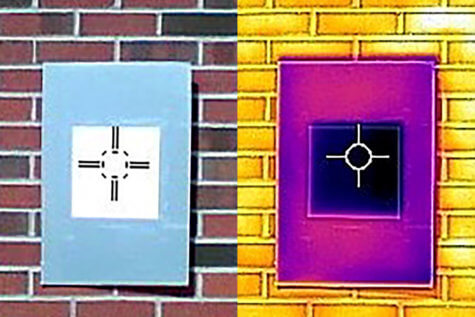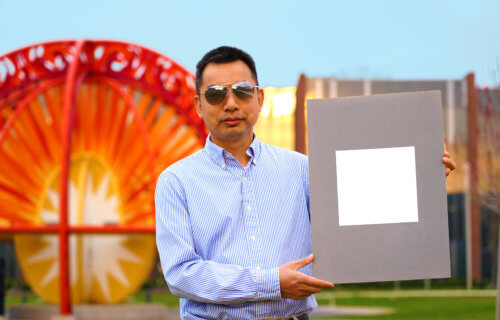WEST LAFAYETTE, Ind. — Enter any hardware store and you’ll find plenty of different shades of white in the paint section. Soon, you may be able to add one more. How will you know which one it is? Engineers at Purdue University say it’s not just the whitest paint ever, but also the coolest.
While that may sound like boasting, their study reveals it really is cooler than other coatings available. The new paint formulation can actually help buildings rely less on air conditioning, thereby using less energy.
In an effort to curb global warming, the Purdue team experimented with creating an ultra-white paint last year to push the limits of how white paint can be. The newer paint is not only whiter, but also can keep surfaces cooler on hot days.
“If you were to use this paint to cover a roof area of about 1,000 square feet, we estimate that you could get a cooling power of 10 kilowatts. That’s more powerful than the central air conditioners used by most houses,” Professor Xiulin Ruan says in a university release.
Paint that reflects nearly all sunlight
The researchers believe this white may be the closest equivalent to the blackest black (Vantablack) which absorbs up to 99.9 percent of visible light.

The new whitest paint formulation reflects up to 98.1 percent of sunlight. For comparison, the previous best ultra-white paint reflects only 95.5 percent of sunlight. The new formula also sends infrared heat away from a surface at the same time.
Typical commercial white paints get warmer rather than cooler. Heat-repelling paints on the market reflect only 80 to 90 percent of sunlight and can’t make surfaces cooler than their surroundings.
The team’s research explaining how the paint works appears in the journal ACS Applied Materials & Interfaces.
What makes this paint so unique?
Researchers say two features give the paint its extreme whiteness. One is the paint’s very high concentration of a chemical compound called barium sulfate which is also used to make photo paper and cosmetics white.
“We looked at various commercial products, basically anything that’s white,” Xiangyu Li, a PhD student in Prof Ruan’s lab, explains. “We found that using barium sulfate, you can theoretically make things really, really reflective, which means that they’re really, really white.”
The second feature is that the barium sulfate particles are all different sizes in the paint. How much each particle scatters light depends on its size, so a wider range of particle sizes allows the paint to scatter more of the light spectrum from the sun.
“A high concentration of particles that are also different sizes gives the paint the broadest spectral scattering, which contributes to the highest reflectance,” says Joseph Peoples, a Purdue PhD student in mechanical engineering.
The team says there is still a “little bit” of room to make the paint even whiter, but not much without compromising the paint.
“Although a higher particle concentration is better for making something white, you can’t increase the concentration too much. The higher the concentration, the easier it is for the paint to break or peel off,” Dr. Li adds.
It doesn’t get any cooler than this, literally
The paint’s whiteness also means that it is the coolest paint on record. Using high-accuracy temperature reading equipment called thermocouples, the researchers demonstrated outdoors that the paint can keep surfaces 19 degrees cooler than their ambient surroundings at night. It can also make surfaces eight degrees cooler than their surroundings under strong sunlight during the afternoon.
The paint’s solar reflectance is so effective, it even works in the middle of winter. During an outdoor test with an ambient temperature of 43 degrees Fahrenheit, the paint still managed to lower the sample temperature by 18 degrees.
Dr. Ruan says the paint is the result of six years of research, building on attempts going back to the 1970s to develop radiative cooling paint as a feasible alternative to traditional air conditioners. His lab examined more than 100 different materials, narrowing them down to 10 and testing about 50 different formulations for each material.
Their previous ultra-white paint was a formulation made of calcium carbonate, commonly found in rocks and seashells. The researchers showed in their new study that, like commercial paint, their barium sulfate-based paint can potentially handle outdoor conditions. The technique used to create the paint is also compatible with the commercial paint fabrication process, according to the Purdue team.
SWNS writer Stephen Beech contributed to this report.
